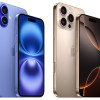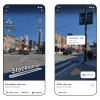Nokia Summer 2007
The N81 was the premier new phone of the event. At first glance, it may slightly resemble an iPhone, but it most definitely is not. The smooth black plastic of the front is attractive, though very prone to smudges. There is a silver lining that frames the entire face of the phone, and this is what lends it a little bit of the iPhone look. The sides and back of the phone are a grayish material that felt like metal. They were smooth, but the silver lining around the face is actually raised out a bit, creating a ridge that digs into your hand. Even though it is far thinner than the N95, the N81 has a solid weight to it.
The screen was very bright, had good resolution and displayed colors well. Though the front of the phone is dominated by the largish screen, it is hard to ignore the navigation cluster. Eleven buttons are packed onto the bottom of the phone, and using them is a tad tricky. The five-way D-pad is easy enough to use, but it is surrounded with a narrow rectangle that hosts 4 media control buttons, one in each corner. This strip of plastic is so thin, that using it was difficult. The boundary between the D-pad and this strip is well defined, but the boundary between this strip and the other navigation and control buttons is not easy to sense with your thumb. The media control strip is then surrounded by the two function keys on the top corners and main menu key and clear key along the bottom corners. Just to the right of the D-pad, there is another thin silver button that bridges the inner and outer rings. This button launches the media user interface. It also gets in the way when you're trying to slide your thumb to other buttons, as it is raised quite a bit from the surface of the phone. It catches your thumb quite easily. Finally, on the far left and far right edges of the nav cluster are the send and end keys. These keys are positioned right on the very corner of the phone between the front face and left and right sides. They are tiny, and we found them to be exceedingly difficult to find and use.
The slider mechanism was not smooth on several of the N81s we used during the event. Perhaps the springs weren't working, but the sliding action was decidedly sticky and didn't feel solid at all. It gave the impression of a poor build.
Once open, the keypad is a small, flat plastic affair. It is smooth and there is very little indication to your thumb to know that it has moved from one key to another. Even though the keyboard felt a little cheap and plastic-y compared to the rest of the phone, the feedback from the keys was good when pressed.
The revised media user interface of the S60 platform is fun to use. It resembles the carousel action of the picture gallery application, in that you have a 3D view of the media selection. Hitting the D-pad left or right scrolls through the different menus. The processor was snappy, because launching applications was immediate. There was no lag or delay. Most other functions of the S60 platform remain unchanged.
We were unable to make calls to determine call quality, but the stereo speakers were quite loud. They were easily heard in a very loud and busy room. The music coming through the speakers sounded better than what we've heard on many other music-themed phones. It was rich and had depth. That we could tell this in a noisy room is testament to just how good they are. The music also sounded great through the Bose headphones provided by Nokia.
Overall, the N81 is a solid media phone. It does have some ergonomic issues with respect to the navigation cluster and keypad, but the screen is good and it is a fairly attractive bit of hardware.
Here is a short video preview of the N81. You can watch it here:
Or go to YouTube for more viewing and sharing options.










 Nokia Announces Handful of Handsets
Nokia Announces Handful of Handsets
 iPhone 16 Brings More Features to All Price Points, Including New Camera Control
iPhone 16 Brings More Features to All Price Points, Including New Camera Control
 Nothing Teases its First Phone
Nothing Teases its First Phone
 Google Maps Putting Search Results in AR Live View
Google Maps Putting Search Results in AR Live View
 Nokia N95 8GB
Nokia N95 8GB
 Nokia N81
Nokia N81
 Nokia 5610
Nokia 5610

